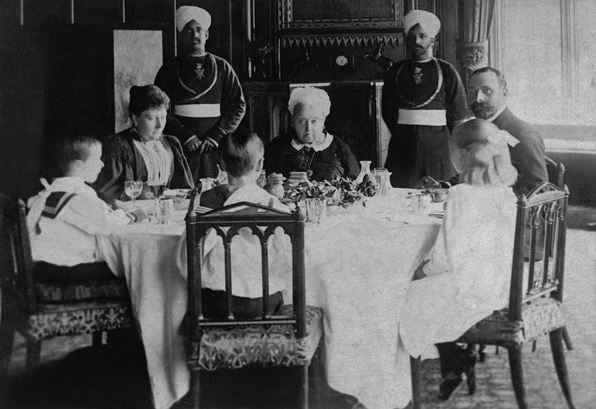
Portrait of a modern monarch: Queen Victoria and the rise of photography

Queen Victoria (1819-1901) 1842 (oil on canvas), Franz Xaver Winterhalter (1805-73) / Château de Versailles, France
24 May 2019 marks the 200th birthday of Queen Victoria, whose iconic 63-year reign came to be known as one of the most successful and innovative periods in British history: the Victorian era. This period in history was full of incredible inventions including typewriters, tarmac, sewing machines and afternoon tea. Another invention of the nineteenth century, which has become indispensable to our own 21st-century lives, is the medium of photography. The Queen herself, a true lady of her time, did not shy away from the camera and used the medium in many clever ways to create her own public image, and to get closer to the British people. Rare early photography from our archive showcases not only the impact and beauty of this new medium, but also traces the life of one of England’s most beloved monarchs.
The invention of photography and the Victorian age

View from a window at Le Gras, Saint-Loup-de-Varennes, 1827 (b/w photo), Joseph Nicephore Niepce (1765-1833) / Gernsheim Collection, University of Texas, Austin, USA / Archives Charmet

Daguerreotype camera by Alphonse Giroux of Paris (wood), French School, (19th century) / National Media Museum, Bradford, West Yorkshire
The very first photographs originate in France, where an inventor named Joseph Niepce, after years of experimentation, captured a view from his own window in 1826-7. The first more commercially viable photography came from his business partner Louis Daguerre, whose “daguerreotype” camera only required a few minutes of exposure time, as opposed to the lengthy 8 or 9 hours required for Niepce’s technique. He had competition in England, where William Henry Fox Talbot conducted successful experiments with different chemicals. The advent of photography turned Europe on its head: people could now easily have their photo taken by photographers (making “portraiture” more accessible). In some cases the camera even exposed more than the eye could witness, as was the case with Eadweard Muybridge’s “motion photography”, which gave unprecedented insights into what animals and humans looked like mid-movement. Towards the end of the nineteenth century, Kodak released a simple camera that could be used by consumers themselves. Anyone and everyone could now capture the world.

Man and horse jumping a fence, plate 640 from ‘Animal Locomotion’, 1887 (b/w photo), Eadweard Muybridge (1830-1904) / Private Collection / The Stapleton Collection

Advertisement for Kodak cameras from The Illustrated London News, 16 September 1893 including Kodak’s famous slogan You press the button, we do the rest. From 1888 the Kodak box camera took Eastman’s coated paper roll film. Engraving
Portrait of the Queen: homely scenes and wedded bliss

Victoria (1819-1901), queen of Great-Britain and Ireland (1837-1901) and empress of Indies (1876-1901) and prince Consort Albert, photo by Roger Fenton, 1854, one of the first occasions on which she agreed to be photographed

VICTORIA & FAMILY, 1857 The Royal Family on the terrace of Osborne House, 1857. From left to right: Prince Alfred, Prince Albert, Princess Helena, Prince Arthur, Princess Alice, Queen Victoria with the Princess Beatrice in her lap, Princess Victoria, Princess Louise, Prince Leopold & Prince Edward. / Photo © Granger
Queen Victoria quickly caught onto this new medium, and because of the photograph’s infinite reproducibility, pictures of the royal family soon started to appear everywhere. Pictures of Queen Victoria’s reign show an idyllic and homely life: affectionate scenes with her husband, Prince Albert, and days out with her extensive family. This openness about royal life raised a few eyebrows among critics, who claimed she was projecting an image that was too “middle class”. The image the Queen was creating was a strikingly humane picture of royalty, which made her and her family more relatable to the people. The royal couple was very involved in civic duties and openly supported public causes such as charities and museums. This public image was only enhanced by the “realness” of the photograph and its accessibility.

Queen Victoria with her son Edward VII and family (b/w photo), German Photographer, (19th century) / © SZ Photo / Knorr & Hirth
In mourning: Albert remains in the picture

VICTORIA (1819-1901) & FAMILY Queen of Great Britain, 1837-1901. Victoria, in black mourning, with her children and a bust of “Dear Albert,” c. 1863-65. / Photo © Granger
In 1861, Queen Victoria unexpectedly lost her husband Albert, the Prince Consort, to an outburst of typhoid. This unfortunate event changed Victoria’s life and it seems she never recovered. The Queen mourned her husband for the rest of her life, withdrawing from public duties, dressing in black and performing mourning rituals for 40 years. A lot of pictures from the later part of her reign show this transformed monarch. Interestingly, many pictures from after Albert’s death still feature the Prince, only in the shape of busts or portraits. Here, photography makes sure Albert stays in the picture and helps demonstrate that despite her husband’s death, the Queen remained a loyal, loving wife.
Like what you see? Get in touch with your local Bridgeman office for any image research or licensing queries:
North and South America: nysales@bridgemanimages.com
